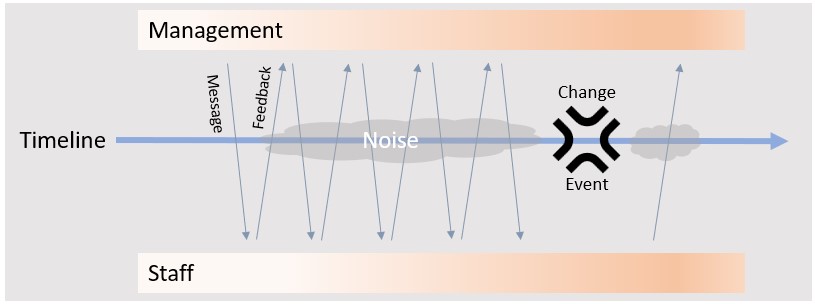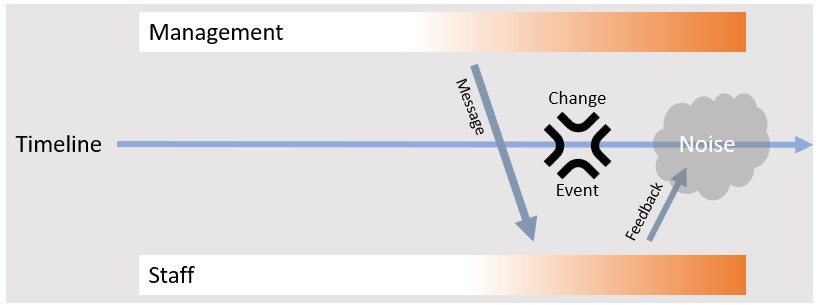
How to Communicate Major Changes with Data Professionals
When you have a major change affecting your data professionals -- from layoffs to budget changes to AI disruptions -- you can minimize long-term problems by communicating in an open, interactive, and consistent style.
- By Stan Pugsley
- May 20, 2024
Think about the last time your business had a major shift that impacted your data professionals, developers, or system administrators. How well did your management team communicate the change and deal with the long-term impact on staff morale and productivity? If you managed the process well, the affected staff members understood and moved on with work; if you managed it poorly, you created turnover and a high risk for loss of institutional knowledge. This article proposes a framework for understanding the impact of your communication style on the long-term health of your department.
Change can be especially difficult for technology and information workers because they tend to have analytical personalities and require strong focus to accomplish their work. Anything that shifts their brain in distracted directions will interfere with that. Some distractions are built in, such as the office layout, hallway chatter, or work-from-home side activities. Other distractions are manufactured, such as long and frequent meetings, office politics, looming changes, or job insecurity. As a manager of data-oriented professionals, you should actively look for opportunities to eliminate those distractions and provide long periods for your employees to focus.
Major changes to the business become unavoidable distractions that will hit the staff sooner or later. Each management group needs to decide how and when to communicate the change. In the following diagrams are two contrasting models for communication based on business communication theory (Shannon and Weaver).
The first type involves an interactive, open dialogue during the entire time the change is being formulated and enacted. Staff members can respond and provide input during the entire period. The noise and distraction to staff will persist for an extended period during the lead-up to the change, but at a moderate level. (See Figure 1.)

Figure 1: Communication type 1: Communicating early and interactively.
In the second type of communication, the management team withholds information as long as possible to minimize disruption, then delivers a controlled, one-directional announcement to staff shortly before the change is implemented. The emotional turmoil (noise) hits much later in the process, but with more intensity, and the high level of noise after the change may prevent rational feedback from making its way back to management. (See Figure 2.)

Figure 2: Communication type 2: Communicating late and linearly.
Although good arguments could be made for both types, depending on the change in question and the makeup of your workforce, type 1 is a better approach when dealing with data professionals for several reasons.
- Skilled data-focused workers are in high demand in the labor market and those workers are at especially high risk of turnover as a result. Type 2 creates a seismic event that could easily push workers to consider talking to a recruiter or checking online job sites.
- Analytical personalities seek reasons and facts behind any change; the more information they have, the more their thoughts will be able to make rational sense of the change and move back to productive activities. They think in creative ways. Their training has taught them to approach problems from many angles. Linear, controlled communication does not allow them to ask questions and resolve concerns, leading to uncontrolled speculation and thought spinning.
- Your staff may help you discover alternatives and ideas that may improve the process or prevent the need for change. Your knowledge workers are trained to solve problems; give them a chance to help solve yours!
A Case Study
Consider a large hospital system planning to outsource many of the non-core business functions. With Type 1 communication, they would begin laying out the rationale and context for the change several months before the anticipated change. A series of recurring meetings would be organized at various levels of the organization to consider the impacts on projects, production systems, and people. Managers would collect feedback and tweak the plans as new information emerges about risks or issues. They could also help staff members understand how they might transition to working with a new resource and prepare for the change. This would create a level of noise for many weeks as emotions come to the surface and misinformation may circulate, but at the point of the final change, most staff should be well prepared.
With a Type 2 communication style, the announcement would come in a formal meeting with plans already finalized and detailed instructions for next steps provided for every team. The work disruption would be minimal before the change due to the short time frame, but the disruption after the change would be epic and unpredictable. Staff members would be unable to process many of their questions and uncertain about whom to talk to, forcing them to take their frustrations home for the weekend or onto social media. This may suit some managers well if they prefer to avoid a drawn-out, awkward conversation for many months prior, but they have put the business at risk of serious worker upset and high turnover.
Making the Right Choice
Management teams have an inherent personality and culture that may fit more naturally with one of these two communication types. You may have a CEO who is uncomfortable spending the time and emotional energy to have a series of dialogues and unpredictable feedback, so making the case for communication style 1 may be an uphill battle. However, for the sake of your business innovation and efficiency, you must keep your data professionals on board and productive.
About the Author
Stan Pugsley is an independent data warehouse and analytics consultant based in Salt Lake City, UT. He is also an Assistant Professor of Information Systems at the University of Utah Eccles School of Business. You can reach the author via email.